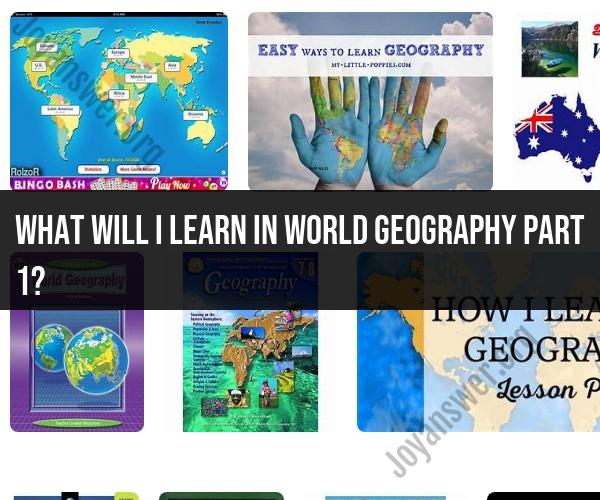What will I learn in World Geography Part 1?
The specific learning objectives in a course titled "World Geography Part 1" may vary depending on the educational institution, curriculum, and grade level. However, in a typical world geography course, whether it's in a high school or college setting, you can expect to cover a wide range of topics and concepts related to geography, with an emphasis on the fundamentals. Here are some common learning objectives you might encounter in a World Geography Part 1 course:
Geographic Terminology: Develop a fundamental understanding of key geographic terms and concepts, such as latitude, longitude, equator, prime meridian, continents, and oceans.
Physical Geography: Study the Earth's physical features, including landforms (mountains, valleys, plateaus), bodies of water (rivers, lakes, seas), and natural phenomena (volcanoes, earthquakes, weather patterns).
Human Geography: Explore the relationship between humans and their environment, including topics like population growth, migration, urbanization, and cultural landscapes.
Geopolitical Regions: Examine the world's major regions, including continents and subregions, and learn about their unique physical, cultural, and political characteristics.
Maps and Cartography: Develop map-reading skills, understand different types of maps (topographic, political, thematic), and interpret map symbols, scales, and legends.
Spatial Awareness: Gain proficiency in using latitude and longitude coordinates to locate places on the Earth's surface and understand the concept of scale in geography.
Climate and Weather: Explore the factors influencing climate, weather patterns, and climate zones around the world. Learn about the impact of climate on ecosystems and human societies.
Cultural Diversity: Study the cultural diversity of the world's populations, including languages, religions, customs, traditions, and the diffusion of cultural practices.
Economic Geography: Understand the distribution of resources, economic activities (agriculture, industry, services), and global trade patterns.
Environmental Issues: Investigate environmental challenges and issues such as deforestation, pollution, climate change, and sustainability efforts on a global scale.
Global Challenges: Analyze global challenges, including geopolitical conflicts, migration trends, and humanitarian crises, and their impact on the world.
Geographic Tools: Familiarize yourself with various geographic tools and technologies, such as Geographic Information Systems (GIS), satellite imagery, and remote sensing.
Spatial Analysis: Develop the ability to analyze and interpret spatial data, make geographic comparisons, and draw conclusions from geographic information.
Cultural Geography: Explore how geography influences culture and how cultural factors can shape geographic landscapes and regions.
Case Studies: Investigate specific geographic case studies or real-world examples to apply geographic concepts and principles to practical situations.
The precise content and depth of these topics may vary, but a World Geography Part 1 course typically lays the foundation for further study in geography and provides students with a comprehensive understanding of the Earth's diverse physical and human landscapes. It aims to foster geographic literacy and a global perspective.
World Geography Part 1 is a course that covers the physical and human geography of the world. The course typically covers the following topics:
- The Earth's physical systems: This includes the Earth's structure, atmosphere, hydrosphere, lithosphere, and biosphere.
- The Earth's human systems: This includes population, migration, culture, economics, and politics.
- The Earth's regions: This includes the major geographical regions of the world, such as North America, South America, Europe, Asia, Africa, and Australia.
In addition to these general topics, World Geography Part 1 may also cover specific topics such as:
- Global climate change
- Natural hazards
- Sustainable development
- Globalization
- Geopolitical conflicts
The specific topics covered in World Geography Part 1 will vary depending on the curriculum and the instructor. However, all World Geography Part 1 courses should provide students with a broad understanding of the physical and human geography of the world.
Here are some examples of what you might discover in World Geography Part 1:
- How the Earth's physical systems interact to create the world we live in
- How human activities have shaped the Earth's landscape and climate
- The diverse cultures and economies of the world
- The major geopolitical challenges facing the world today
World Geography Part 1 is an important course for anyone who wants to understand the world around them. It can help you to develop a global perspective and to appreciate the interconnectedness of the world.













